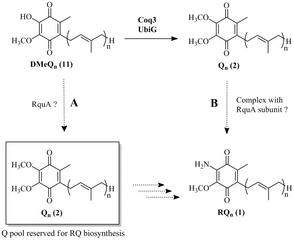Shepherd
Research
Dr. Shepherd's research seeks to elucidate the biosynthetic pathway of rhodoquinone (RQ, 1 in Figure 1) which will later be used as a target for the development of new anti-parasitic drugs. RQ is an essential electron carrier used in the anaerobic energy metabolism of species such as the parasitic helminths, the free-living nematode Caenorhabditis elegans (C. elegans), and the purple non-sulfur bacterium, Rhodospirillum rubrum (R. rubrum). RQ is not synthesized or used in humans and other mammals with a primarily aerobic energy metabolism. However, RQ is structurally similar to ubiquinone (coenzyme Q or Q, 2 in Figure 1), an important lipid component involved in electron transport in the aerobic respiratory chain, and the biosynthetic pathways of RQ and Q are proposed to be similar. The biosynthesis of Q has been well-characterized in both prokaryotic and eukaryotic species.
It has recently been shown by Dr. Shepherd's laboratory that catabolism of Q is required for RQ biosynthesis in R. rubrum. A mutant strain (F11) of R. rubrum has also been identified which can synthesize Q, but not RQ, and therefore cannot grow anaerobically. After sequencing the whole genome of F11, and a spontaneous revertant (RF111), we identified a new gene rquA, which is the first known gene required for RQ biosynthesis. We are currently working on the expression, purification and characterization of the gene product (RquA). Using bioinformatics and RNA sequencing data, we are also investigating additional candidate genes responsible for RQ biosynthesis in R. rubrum. In addition, we have begun work with the C. elegans worm model using RNAi gene knock-downs to identify further candidates required in the RQ biosynthetic pathway. Characterization and regulation of unique enzymes in the RQ biosynthetic pathway will provide a novel target for antihelminthic drug discovery.

It has recently been shown by Dr. Shepherd's laboratory that catabolism of Q is required for RQ biosynthesis in R. rubrum. A mutant strain (F11) of R. rubrum has also been identified which can synthesize Q, but not RQ, and therefore cannot grow anaerobically. After sequencing the whole genome of F11, and a spontaneous revertant (RF111), we identified a new gene rquA, which is the first known gene required for RQ biosynthesis. We are currently working on the expression, purification and characterization of the gene product (RquA). Using bioinformatics and RNA sequencing data, we are also investigating additional candidate genes responsible for RQ biosynthesis in R. rubrum. In addition, we have begun work with the C. elegans worm model using RNAi gene knock-downs to identify further candidates required in the RQ biosynthetic pathway. Characterization and regulation of unique enzymes in the RQ biosynthetic pathway will provide a novel target for antihelminthic drug discovery.

Figure 1. Schematic representation of potential ways RquA acts in the biosynthesis of RQ. Pathway A represents the methylation of DMeQ to form a pool of Q reserved for the biosynthesis of RQ. Pathway B represents a complex in which RquA acts in conjunction with other enzymes to act as an amidotransferase to substitute Q's methoxy group with an amino group on RQ.
